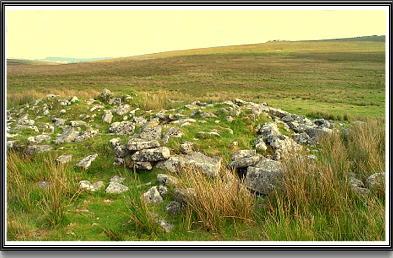
High up on the moor between Rough tor and Lower White tor is probably one of the most desolate spots on the moor. Today all you can see is a boggy tract of land where the cotton grass waves in the wind like a multitude of rabbits tails. In summer there is the occasional spire of pink as the cow flops (fox gloves) briefly blossom. Cows and sheep graze on the lusher patches of grass which lie on the boggy edge of the mire. But on the edge of the morass are the forlorn remnants of human habitation in the form of the ruins of a small house. This is what is left of Browne’s House, the actual bog is now called Browne’s House Bog and come rain or shine there is always a sombre feel to the place.
Nearly two hundred years ago lived a man called Browne, one account describes him as an “ungainly morose man,” and that came from a Reverend of the area. Somehow Browne met a beautiful woman and it was not long before they were married. Amongst his other attributes was that of jealousy and woe betide any man that should even glance at his new wife. As time went by his jealousy grew almost into an obsession. Probably he realised how fortunate he was and was going to make sure that temptation was put out of harms way. To this end he chose one of the most remote areas of the moor and built a small farm. Even the locals were amazed, it was said that the farm was that secluded that only the occasional shepherd, rushcutter or fisherman would ever pass by and that was on a fine day. One can only imagine how his wife felt because from the day they moved to the farm very little was seen or heard of her. She must have led a lonely and miserable life if the location of the farm and the nature of the farmer are taken into account. And there the story ends because nobody seems to know what became of Browne and his pretty wife, clearly a case of ‘out of sight, out of mind’.

The Ruins of Browne’s House.
In reality it was a man called Brown who built the farm his name was Dr Benjamin Hayward Brown. He was a “Doctor of Physic” and lived near Chagford at a place called Withecombe. During the early 1800’s many ‘improvers’ were successfully enclosing large areas of moorland with the idea of building farms. Dr Brown decided that he too wanted a piece of the so-called action and in 1810 started work on his new farm. Sadly he got it slightly wrong because it was not enough simply to apply to the Duchy of Cornwall for a lease (which he did in May 1810), one actually had to be granted the lease before work could commence. Accordingly Dr. Brown started work on the farm, he had applied to build “one good and substantial messuage or farm house with suitable outbuildings.”
As one can imagine the Duchy were not overjoyed when they discovered that Dr. Brown had not waited to secure his lease before starting work. Accordingly their displeasure was demonstrated when they did officially grant the lease in the January of 1811. Instead of charging the average rent of 1s per acre they charged Dr. Brown 1s. 6d an acre. This presented a dilemma, did Dr. Brown carry on with the farm and face certain financial difficulties or should he abandon the farm and lose all he had invested in the project? Eventually the Duchy relented somewhat and agreed to reduce the rent to 1s. 3d on condition that at his own expense, Brown built an access road to the farm. This would have meant a distance of about two and a half miles and clearly was not a cheap alternative. By 1812 the farm house and buildings were completed, the dwelling consisting of a single storey with two rooms. It is possible that the water supply came from a nearby spring although there is a suggestion that a pot-water leat was driven off the Cherrybrook. There was one small outbuilding but this is thought to have been an old tinner’s hut and to have pre-dated the farm. It is possible that cattle were the main concern at the farm because local tradition records how milk and butter was sold to the French prisoners interned at Princetown during the Napoleonic Wars. In June 1812, Dr. Browne sold the lease for £700 despite having constructed the buildings and some of the enclosure walls, Stanbrook, 1994, pp. 114-120. The modern Ordnance Survey maps shows both the remoteness of the farmstead and the partially finished enclosure walls.
The following seventeen years saw the farm change hands several times and by 1829 all references to Brown’s House stop. It therefore can be assumed that sometime after this date the place was abandoned to the ravages of the moor. The access road was never built by any of the lessees or tenants and it appears that over the eighteen year life of the farm nobody made any money. Here is yet another example of how nobody gets rich from trying to exploit Dartmoor – Old Crockern sees to that!
Bibliography.
Stanbrook, E. 1994 Dartmoor Forest Farms, Devon Books, Tiverton.
 Legendary Dartmoor The many aspects past and present of Dartmoor
Legendary Dartmoor The many aspects past and present of Dartmoor
